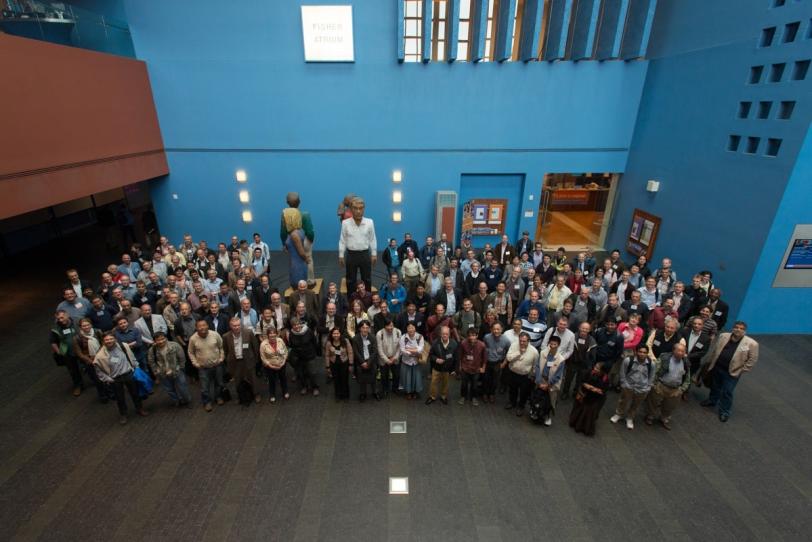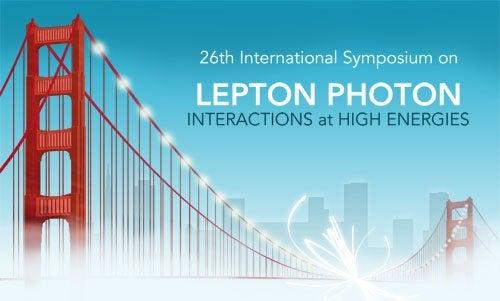Lepton-Photon Conference Wraps Up in San Francisco
Last Saturday, about 230 high-energy physicists of various stripes wrapped up a week of talks on all aspects of the field at the XXVI International Symposium on Lepton Photon Interactions at High Energies – known among physicists, not surprisingly, as Lepton-Photon.
By Lori Ann White
Last Saturday, about 230 high-energy physicists of various stripes wrapped up a week of talks on all aspects of the field at the XXVI International Symposium on Lepton Photon Interactions at High Energies – known among physicists, not surprisingly, as Lepton-Photon. Held in San Francisco and hosted by SLAC (with help from the University of California-Santa Cruz and Lawrence Berkeley National Laboratory), the conference summarized the latest developments in a wide range of subatomic studies. The breadth of this view – from theory to experiment, from colliders to the cosmos, and from antimatter to dark matter to the regular matter that makes up the visible universe, plus dark energy and gravitational waves thrown in for good measure – makes Lepton-Photon unique among high energy physics conferences.
Lepton-Photon trades off with the International Conference of High Energy Physics, ICHEP, as the year's premier gathering for the field. And the biggest news of last year's ICHEP in Melbourne, Australia was still the biggest news at this year's Lepton-Photon: the discovery of a Higgs boson at CERN’s Large Hadron Collider. Progress has been made in the past year: The new particle, which was originally reported as a "Higgs-like" boson, was confirmed as a Higgs boson (if not yet the one and only Higgs boson) in March.
During the conference both Karl Jakobs of ATLAS and Albert De Roeck of CMS – the two LHC experiments that served up the Higgs to the world – said investigations into the particle have gone beyond the discovery stage. Researchers are now measuring its properties, trying to figure out how it fits into the giant jigsaw puzzle depicting energy and matter known as the Standard Model.
Clarifying the properties of the Higgs boson will also enable physicists to determine properties of some other particles that had not been pinned down. It's as though the addition of each new piece to the Standard Model puzzle causes a subtle shift in how the other pieces look. For example, researchers can plug the mass of the Higgs into measurements of the mass of the W boson, and, because of the way the two particles are related, look for contributions to the W boson mass from new, beyond-Standard-Model physics, courtesy of quantum fluctuations.
But the universe is a deeper puzzle than the Standard Model, said theorist Hitoshi Murayama of the University of California-Berkeley and the Kavli Institute for the Physics and Mathematics of the Universe, who gave the final talk, "The View Ahead."
"We know we need to find more pieces beyond the Standard Model," he said, listing what he sees as the five most important missing pieces to look for:
- Dark matter
- Dark energy
- Neutrino masses
- What drove cosmic inflation
- The absence of antimatter
Murayama related the frustration of some of his colleagues that the new boson seems to cast so little light on the missing pieces; according to one he quoted, a Higgs boson with a mass of about 125 GeV "seems almost maliciously designed to prolong the anguish" of physicists searching for what lies beyond the Standard Model. Murayama counseled patience, however. The CDF experiment at the now-shuttered Tevatron collider at Fermi National Accelerator Laboratory took a decade to find the top quark, he said, while the LHC has been running – at only half its planned energy, at that – for just three years.
In the meantime, there are other ways to look for his five missing puzzle pieces, including techniques that may not have even been conceived of yet – which reveals another purpose for the conference. Before the talks, after the talks, sometimes even during the talks, Murayama said, he saw scientists from different areas talking together about the presentations and bouncing ideas off each other – new experiments being born like stars in a dense cloud of interstellar gas.
JoAnne Hewett, conference chair and head of SLAC's Particle Theory Group, put it in a more down-to-earth way: "At Lepton-Photon, speakers come prepared to reach out to other attendees. Opportunities such as this conference provide for the cross-pollination of ideas and can help make really beautiful ideas bloom."

